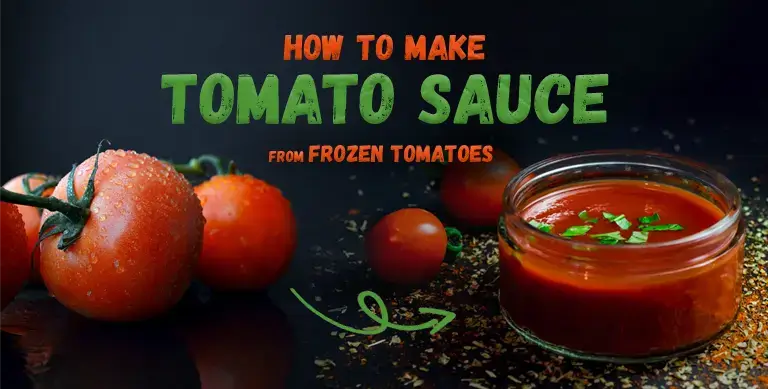
Have you ever found yourself with an abundance of frozen tomatoes taking up precious space in your freezer? Fear not, for those forgotten fruits can be transformed into a delicious homemade tomato sauce that will elevate your dishes to new heights! In this guide on how to make tomato sauce from frozen tomatoes, we will unravel the secrets to unlocking the rich flavors trapped within those icy orbs. Prepare to embark on a culinary adventure as we melt away the frost and reveal a savory concoction that is sure to impress even the most discerning palates.
Table of Contents
Benefits of using frozen tomatoes

When it comes to making tomato sauce from frozen tomatoes, one key benefit is the enhanced flavor profile. Freezing tomatoes helps to intensify their natural sweetness and acidity, resulting in a richer and more robust sauce. Additionally, frozen tomatoes are incredibly convenient as they can be stored for months without losing much of their nutritional value.
Another advantage of using frozen tomatoes for your sauce is the ease of preparation. Once thawed, the skins easily slip off, making the tomatoes ready to be cooked down into a velvety smooth sauce without any hassle. This method also allows you to make tomato sauce year-round, even when fresh, ripe tomatoes are out of season.
Incorporating frozen tomatoes into your recipes not only saves time but also reduces food waste by utilizing excess produce that may otherwise go unused. By stocking your freezer with a batch of frozen tomatoes, you can whip up a delicious homemade tomato sauce at a moment’s notice, adding depth and complexity to your culinary creations.
Cooking Process: How to Make Tomato Sauce from Frozen Tomatoes

1. Thaw the tomatoes
Thawing frozen tomatoes for homemade tomato sauce is a simple yet crucial step in preserving the vibrant flavor of the fruit. To begin, place the frozen tomatoes in a bowl and leave them to thaw at room temperature for several hours or overnight in the refrigerator. Once fully thawed, gently squeeze each tomato to release excess liquid and make peeling easier.
2. Peel the tomatoes
Peeling tomatoes may seem tedious, but it’s a necessary process to achieve a smoother texture and enhance the overall taste of your sauce. An efficient way to peel tomatoes post-thaw is by blanching them in boiling water for about 30 seconds until the skin starts to crack. Transfer immediately to an ice bath before peeling off the skin effortlessly, revealing ripe and juicy flesh ready for simmering into a rich and flavorful tomato sauce.
3. Chop the tomatoes
Once your tomatoes are thawed and peeled, it’s time to chop them up for your homemade tomato sauce. Start by cutting off the stem end of the tomato and then slicing it in half. Use a spoon to scoop out the seeds and any excess liquid, as this will ensure that your sauce isn’t too watery. Then, you can finely chop the tomatoes into small pieces, ensuring that they will break down easily during the cooking process.
If you prefer a smoother sauce, you can also use a food processor or blender to puree the tomatoes to your desired consistency. Chopping the tomatoes is a crucial step in the process of making your own sauce, and it allows you to control the texture and flavor of your final dish.
4. Simmering and seasoning
Simmering and seasoning are important steps in the cooking process that can elevate the flavor of your dishes. After chopping the tomatoes for your homemade sauce, it’s time to simmer them on the stove. Simmering allows the flavors of the tomatoes and any additional ingredients to meld together, resulting in a rich and flavorful sauce. To simmer, simply bring the tomato mixture to a gentle boil, then reduce the heat and let it cook at a low temperature. This slow cooking process allows the sauce to thicken and develop a deeper flavor profile.
Once your sauce has simmered to perfection, it’s time to season it. Seasoning is the final touch that can elevate the taste of your dish. Add salt, pepper, and any other herbs or spices of your choice to enhance the flavor of the sauce. Taste the sauce as you season it to ensure that the flavors are well-balanced. Remember, you can always add more seasoning, but you can’t take it away, so it’s best to start with a little and adjust to taste.
Simmering and seasoning are crucial steps in the cooking process that can transform a simple dish into something extraordinary. By taking the time to simmer your sauce and season it to perfection, you can create a delicious and impressive meal that will impress your friends and family. So, don’t rush through these steps – embrace them and enjoy the process of creating a delicious homemade sauce.
5. Blend the cooked tomatoes
Along with any other ingredients in the recipe to create a smooth and flavorful sauce. This step is important to ensure that the sauce has a consistent texture and that all the flavors are well incorporated. Using a blender or food processor, process the cooked tomatoes until you achieve the desired consistency. Be sure to taste the sauce after blending to check for any additional seasoning or adjustments that may be needed. Once blended, the sauce is ready to be used in your favorite dishes, adding a delicious and rich flavor to your meals.
Storage tips for leftover sauce

Include making sure the sauce has cooled completely before transferring it to an airtight container. This will help prevent any bacterial growth. It’s important to refrigerate the sauce promptly, ideally within two hours of cooking, to keep it fresh and safe to eat. When storing the sauce in the refrigerator, make sure to label the container with the date it was made so you can keep track of how long it has been stored.
Leftover sauce can also be frozen for longer-term storage. Place it in a freezer-safe container, leaving some space at the top to allow for expansion as the sauce freezes. It’s also helpful to label the container with the date and type of sauce. When reheating the sauce, make sure to do so thoroughly, reaching a temperature of at least 165°F to ensure it’s safe to eat. By following these storage tips, you can make the most of your delicious homemade sauce and enjoy it for days to come.
Recipe variations and customization

Recipe variations and customization are a great way to make a dish your own and cater to your specific tastes. Whether it’s adding extra spices, substituting different ingredients, or changing the cooking method, there are endless possibilities for customizing a recipe. You can make a dish spicier, sweeter, or healthier by making simple adjustments to the recipe. Experimenting with variations can also help you discover new flavor combinations and enhance your culinary skills.
Additionally, customizing a recipe allows you to accommodate dietary restrictions or preferences, making the dish enjoyable for everyone. With a little creativity and willingness to try new things, you can create unique and personalized dishes that reflect your individuality and taste preferences. So don’t be afraid to get creative and make a recipe your own!
Conclusion
Making homemade tomato sauce from frozen tomatoes is a great way to enjoy the taste of summer all year round. By following these simple steps, you can create a delicious sauce that will elevate any dish. Whether you use it for lasagna, chicken sausage, pasta, pizza, or as a base for soups and stews, homemade tomato sauce is a versatile and flavorful addition to any meal. So, next time you have an abundance of tomatoes, give this recipe a try and enjoy the delicious taste of homemade tomato sauce.
FAQ
Can I use frozen tomatoes with other ingredients to make a flavorful sauce?
Absolutely! You can add herbs, garlic, onions, and other seasonings to enhance the flavor of your tomato sauce.
How long does it take to make tomato sauce from frozen tomatoes?
The cooking time will vary depending on your recipe and desired consistency, but it usually takes about 1-2 hours.
Are there any tips for making a delicious tomato sauce from frozen tomatoes?
To enhance the flavor of your tomato sauce, consider adding a splash of balsamic vinegar or a pinch of sugar to balance out the acidity of the tomatoes.
Can I use any type of tomato to make sauce from frozen tomatoes?
Yes, you can use any variety of tomatoes for making sauce from frozen ones, though plum or Roma tomatoes are often preferred for their rich flavor.
How can I enhance the flavor of my tomato sauce made from frozen tomatoes?
To elevate the flavor of your sauce, consider adding a splash of red wine, a drizzle of balsamic vinegar, or a sprinkle of grated Parmesan cheese. Taste as you go and adjust the seasonings to your preference.

Tomato Sauce
Ingredients
- 3 pounds frozen tomatoes
- 2 tablespoons olive oil
- ½ cup onion chopped
- 3 cloves garlic minced
- 1 teaspoon dried oregano
- ½ teaspoon dried basil
- salt to taste
- black pepper to taste
Optional Ingredients
- Splash of red wine or balsamic vinegar
- Pinch of sugar
- Fresh herbs like basil or parsley
- Grated Parmesan cheese
Instructions
- Thaw the Tomatoes: Remove your frozen tomatoes from the freezer and allow them to thaw. You can do this by leaving them on the counter for a few hours or placing them in the refrigerator overnight.
- Prep the Produce: While the tomatoes are thawing, chop the onion and mince the garlic.
- Sauté Aromatics: Heat the olive oil in a large pot or Dutch oven over medium heat. Add the chopped onion and cook until softened, about 5 minutes. Stir in the minced garlic and cook for an additional minute until fragrant.
- Peel and Chop Tomatoes: Once the tomatoes are thawed, peel them (blanching in hot water makes this easier). Roughly chop the peeled tomatoes.
- Add Tomatoes and Season: Add the chopped tomatoes to the pot along with the dried oregano, basil, salt, and pepper. Stir to combine.
- Simmer: Bring the sauce to a gentle simmer, then reduce heat to low. Let it simmer, uncovered, for at least 30 minutes, or up to 2 hours for a thicker, richer sauce. Stir occasionally.
- Taste and Adjust: Taste the sauce and adjust seasonings as needed. You can add a splash of red wine or balsamic vinegar for extra depth, or a pinch of sugar to balance the acidity.
- Blend (Optional): For a smoother sauce, use an immersion blender or transfer the sauce to a regular blender and puree until your desired consistency.
- Serve and Enjoy: Use your delicious homemade tomato sauce immediately on pasta, pizza, in lasagna, or in any recipe that calls for tomato sauce.
Notes
- Fresh Herbs: If you have them, add some chopped fresh basil or parsley at the end for extra brightness.
- Make Ahead: This sauce freezes beautifully, so make a big batch and store for later.
- Customization: Get creative with other additions like mushrooms, bell peppers, or even a little ground meat.





